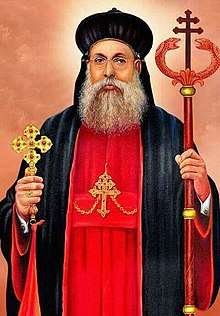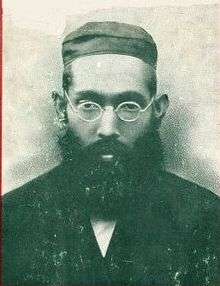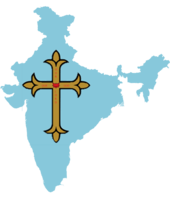Geevarghese Ivanios
Aboon Geevarghese Ivanios (born 21 September 1882 as Geevarghese Panickeruveetil - died 15 July 1953) was the first Metropolitan Archbishop of the Syro-Malankara Catholic Church and Major Archdiocese of Trivandrum..[1] He was the founder of Bethany Ashram order of monks and Bethany madom Order Of Nuns. He was the first M.A. degree holder in the Malankara Church. He also served as the Principal of the Kottayam M.D Seminary High School and as a professor at Serampore College.
Servant of God Aboon Geevarghese Ivanios | |
|---|---|
| First Archbishop of Trivandrum, Founder and First head of the Syro Malankara Catholic Church. | |
 Painting of Ivanios outside of the Archiepiscopal Curia of Trivandrum, in Kerala, India | |
| Church | Syro-Malankara Catholic Church |
| See | Syro-Malankara Catholic Major Archeparchy of Trivandrum |
| Installed | 11 June 1932 |
| Term ended | 15 July 1953 |
| Predecessor | None (seat created) |
| Successor | Benedict Gregorios |
| Orders | |
| Ordination | 15 September 1908 by Vattasseril Dionysius |
| Consecration | 1 May 1925 by His Holiness Baselios Geevarghese I |
| Personal details | |
| Birth name | Geevarghese Panickeruveetil |
| Born | 21 September 1882 Mavelikkara, Kerala |
| Died | 15 July 1953 (aged 70) Thiruvananthapuram, Kerala |
| Buried | St.Mary's Cathedral, Pattom, Trivandrum |
| Nationality | |
| Previous post | Metropolitan Archbishop of Malankara Orthodox Syrian Church |
Family history, childhood and education
Geevarghese Panicker was born in Mavelikkara, Kerala, India, on 21 September 1882 to Thomas Panicker and Annamma Panicker.
He was a descendant of the aristocratic tharavad of Panickervettil in Mavelikkara within the erstwhile Indian princely state of Travancore, currently in the Alappuzha district of Kerala. The Panickervettil family was honored with the title of 'Mylitta Panicker' bestowed upon by Marthanda Varma, the Maharaja of Travancore. Panicker's family lineage also includes his being a grandson of the aristocratic Saint Thomas Christian family Polachirackal with their tharavad in Mavelikkara. The Polachirackal House held the highest-ranking hereditary title for a Christian family in Travancore being of nobility titled Tharakan and were of the highest-ranking Christian peer to the Maharaja of Travancore. The Polachirackal House through Saint Thomas Christian Syro-Malankara Catholic Church is acknowledged by Pope Pius XI (and continues to be so by the Holy See of the Vatican City) as one of the oldest Saint Thomas Christian families. The House had evolved from accumulating great wealth from their oligopoly in black pepper trading as part of the spice trade controlled by the Dutch East India Company during the age of discovery between the 16th and 18th centuries. The House's great wealth allowed them to become the court financiers to Marthanda Varma and finance the Kingdom of Venad during the Travancore–Dutch War in the 18th century against the Dutch East India Company. This culminated in funding the Battle of Colachel in 1741 leading to Marthanda Varma's defeat of the Dutch East India Company which was the first loss of its kind by a European naval superpower in the Indian sub-continent. The House were signatories to the Treaty of Mavelikkara in 1753 contributing to the establishment of the Kingdom of Travancore, diminishing the role of the Dutch East India Company in the Indian subcontinent and leading to the rise of Marthanda Varma and the Travancore royal family.
Geevarghese Panicker had his early education in Protestant and government schools. From 1897 he attended M. D. Seminary High School, Kottayam and pursued his higher studies at Serampore College and Madras Christian College (M.C.C.). He completed his matriculation education in 1899: before which he received minor orders (of clerical life) on 20 September 1898. [2]
Deacon
He was ordained deacon by Pulikkottil Dionysius then the Malankara Metropolitan of Malankara Orthodox Syrian Church on 9 January 1900, he then continued his studies at CMS College, Kottayam and obtained a bachelor's degree in Economics and Indian History from Madras Christian College. In 1907 he took a Master's Degree (MA) with distinction from the same college. On his return from Madras he was appointed principal of his Alma Mater, M.D.Seminary High School. During this time he led various schemes for the renewal of the Malankara Church. He organized basic church communities, commenced Bible conventions, because of this he was popularly entitled "Koodasa Semmasan" (Deacon of Sacraments).[3]
Priestly life

He was ordained to the priesthood as P.T. Geevarghese on 15 September 1908 by Vattasseril Dionysius then the Malankara Metropolitan of Malankara Orthodox Church. Geevarghese was popularly known as M A Achan, as he was the first priest with an MA degree in Malankara.[4] At the same time, he took the initiative to empower the Malankara Church with hierarchical autonomy. He became instrumental to erect Catholicate for the Malankara Church on 5 September 1912. After the establishment of Catholicate in 1912 Malankara Church divided into two, one under the leadership of Malankara Metropolitan Vatteseril Dionysius (bishop's party) and one under Anthiochan Jacobite Patriarch(Bava Party). Fr.P.T Geevarghese was belonging to Bishop's party.
Professorship in Serampore
In 1912 Vattasseril Dionysius received an invitation to attend a conference at Calcutta. Dionysius selected Fr. Geevarghese to accompany him to Calcutta to attend the conference. At the conference, they met Dr. Howels the principal of Serampore College who requested the Metropolitan to avail the service of Geevarghese as the professor of the College. The Metropolitan permitted Geevarghese to take up the task. He made use of this opportunity to educate the Malankara Youth. About 20 young people from Kerala reached Calcutta for higher education.[5]
At Serampore, Geevarghese got more time for prayer and contemplation. He came across the writings of St. Basil on monasticism. The Basilian monastic vision had a great influence on him. Besides the visits to the Sabarmati Ashram of Mahatma Gandhi and Santiniketan of Rabindranath Tagore gave him a new vision of Indian Sanyasa (monasticism). These experiences made him to reflect upon starting an order of missionaries to carry out the task of evangelization in India.[6] Slowly the residence of Geevarghese and his followers at Serampore became an Ashram (Monastery), and they began to live a sort of religious life according to the monastic rules of St. Basil, adapting them to Indian culture.[7] As he accepted this as his way of life, he resigned from the Serampore College.
Foundation of the Bethany Ashram
On his return from Calcutta, Geevarghese looked for a location to establish an ashram. One of his friends E. John Vakeel donated 100 acres (400,000 m2) of land at Mundanmala, Ranni-Perunadu, Kerala at the meeting place of the rivers Pampa and Kakkatt. The place was thickly filled with thorny bushes and herbs. Geevarghese and his followers built a small thatched hut made out of the branches of trees and bamboo. This turned to be the first Ashram in Malankara on 15 August 1919. He prayerfully searched for a name for the Ashram and opened the Bible and he got the word "Bethany". He meditated upon it and came to the conclusion that it is an apt name for a religious order which upholds both contemplation and action.[8] Eventually the Bethany Ashram became a place of pilgrimage and spiritual experience. Spiritual retreats and discourses were given by Geevarghese especially in Passion Week. Geevarghese envisioned the Ashram also being a shelter for the poor and the marginalized. Along with the Ashram, he started a house for the orphans.
While at Serampore Geevarghese was thinking of the empowerment of the Syrian Christian women through education. To realize this idea, he took initiative to give education and training to the selected group of young girls with the help of the Epiphany Sisters of England working at Serampore. He founded the Bethany Madom (convent) for the women religious in 1925.
Bishop of Bethany
It was decided by the Malankara Synod to ordain P.T. Geevarghese as the Bishop of Bethany. He was ordained a bishop of the Malankara Orthodox Syrian Church by Baselios Geevarghese I on 1 May 1925. He received the name Geevarghese Ivanios.[9]
Ecclesial communion

On 20 September 1930, Theophilos, John Kuzhinapurath OIC, Alexander Attupurath OIC, and Chacko Kiliyileth made the Catholic profession of faith before Aloysius Maria Benziger OCD, then the Bishop of Kollam. Many of the members of both the Bethany orders also came into full communion with the Roman Catholic Church. This spawned the Syro-Malankara Catholic Church.
Establishment of the Syro-Malankara Catholic hierarchy
In 1932 Ivanios made a pilgrimage to Rome for the reunion as per the letters from Rome and met Pope Pius XI. Ivanios received the pallium. He also participated in the thirty-second Eucharistic Congress held at Dublin, Ireland. There he met G.K. Chesterton, who said to Ivanios "The dignified Indian gentleman, who represented this far off triumph in the Orient, had changed his neighbours by bringing them to the Roman Communion."[10]
On his return from Rome, Ivanios made efforts to build up the Unite Rite establishment of the Malankara Christian Community. Pope Pius XI established the Malankara Catholic hierarchy, Syro-Malankara Catholic on 11 June 1932 through the apostolic constitution Cristo pastorum principi.[11]
Ecumenical endeavours and cultural development of the society
Ivanios sent missionaries to different parts of the land. Besides the newly joined Bishops and Priests from different Malankara denominations, he received missionaries from the Syro-Malabar Catholic Church. Joseph Kuzhinjalil, the founder of the congregation of the Daughters of Mary, was a missionary appointed by Ivanios to work in the southern parts of the land. Under Ivanios's leadership about 75 priests were joined from different denominations of the Malankara Church. About 150 parishes including mission stations were established.[12] A lot of hindus (especially from Nadar (caste) community) also joined the Syro Malankara Catholic Church.[13]
Ivanios established about 50 schools, and one 'A' grade college, named Mar Ivanios College.[14] He visited U.S. President Harry S Truman, G.K. Chesterton, King George V of the United Kingdom, and George Bernard Shaw.
Silver Jubilee of Episcopal Ordination
The Silver Jubilee of the Episcopal Ordination of Ivanios was celebrated in 1951, and Pope Pius XII wrote to him remembering the reconciliation.[15]
Death
Ivanios died on 15 July 1953 and was entombed at St. Mary’s Cathedral, Pattom, Trivandrum.
Writings
Girideepam - Mountain Lamp, Trans. Sr. Rehmas SIC, Cause of Canonization of Mar Ivanios, Trivandrum, 2006.
The Sacrament of Confession: A Meditative Study, Trans. Fr. Samuel Thaikkoottathil Ramban, Cause of Canonization of Mar Ivanios, Trivandrum, 2006.
The Holy Qurbono: An Appraisal and Meditation, Trans. Dr. Bishop Thomas Mar Anthonios (Antony Valiyavilayil OIC), Cause of Canonization of Mar Ivanios, Trivandrum, 2006.
The Liturgical Year: A Theological Reflection, Trans. Fr. Samuel Thaikkoottathil Ramban, Cause of Canonization of Mar Ivanios, Trivandrum, 2006.
A Guide to Malankara Religious Life, Trans. Fr. Samuel Thaikkoottathil Ramban, Cause of Canonization of Mar Ivanios, Trivandrum, 2006.
Servant of God
Ivanios was declared Servant of God (Daivadasan) on 14 July 2007, the day prior to the 54th anniversary of his death. The proclamation was read by his 3rd successor Baselios Cleemis at St. Mary’s Malankara Syrian Catholic Cathedral in Trivandrum, India.
See also
References
Citations
- "The reunion movement among the St Thomas Christians 19th and 20th centuries". Mahatma Gandhi University. 2008.
- From a book "Archbishop Mar Ivanios" by Rev Fr Thomas Injakalodi,Vol. 1,(2006) Chapter-2 Page-27
- Fr. Thomas Inchakkalody, Archbishop Mar Ivanios, Vol. 1, (2006) pp. 72-74.
- Malayala Manorama, 29 July 1908 quoted in Fr. Thomas Inchakkalody, Archbishop Mar Ivanios Vol. 1 (2006), p. 89.
- Fr. Thomas Inchakkalody, Archbishop Mar Ivanios Vol. 1, (2006), pp. 146-147
- L. Moolaveettil, The Spiritual Life of Mar Ivanios, Kottayam, 1977, p.74
- Fr. Thomas Kuzhinapurath, "Mar Ivanios: Bharata Christava Sanyasathinte Pravachakan", Deepika, 15 July 1997.
- Fr. Thomas Inchakkalody, Archbishop Mar Ivanios (Vol.1), pp. 152-171
- Rajan, Matthew (2004). "Baselios Geevarghese I - Second Catholicose". The Christian Light of Life. 3 (12): 221–225.
- G.K. Chesterton, From the Universe, quoted in Fr. Thomas Inchakkalody, Archbishop Mar Ivanios, Vol. 2, Kottayam, 2006, p. 125.
- Pius XI,Cristo pastorum principi in Acta Apostolicae Sedis, XXIV (1932) 289-292.
- Syro-Malankara Catholic Directory, 1973
- "The Nadar Community of Syro-Malankara Catholic Church".
- Fr. Thomas Inchyakkalody, Archbishop Mar Ivanios, Vol. 2, Kottayam, 2006, p. 225.
- Pius XII, "Letter to Archbishop Mar Ivanios" quoted in M. Gibbons, Mar Ivanios (1882-1953) Archbishop of Trivandrum: The Story of a Great Conversion, Dublin, 1962, p.127.
Sources
- "His Grace Most Rev. Geevarghese Mar Ivanios O.I.C."; Bethany Ashram website, retrieved 10 January 2006
- David Cheney. "Archbishop Ivanios Givergis Thomas Panikervitis". Catholic-Hierarchy.org. Retrieved 15 February 2013.
- Maragaret Gibbons, Mar Ivanios (1882–1953) Archbishop of Trivandrum: The Story of Great Conversion, Dublin, 1962.
- L. Moolaveettil, The Spiritual Life of Mar Ivanios, Kottayam, 1977.
External links
| Wikimedia Commons has media related to Geevarghese Mar Ivanios. |
- catholicate.net
- syromalankara.org
- catholic-hierarchy.org
- lightoflife.com
- malankaracatholicchurchuk.com
| Catholic Church titles | ||
|---|---|---|
| Preceded by None (seat created) |
Metropolitan Archbishop of Trivandrum 1932–1953 |
Succeeded by Benedict Gregorios |
